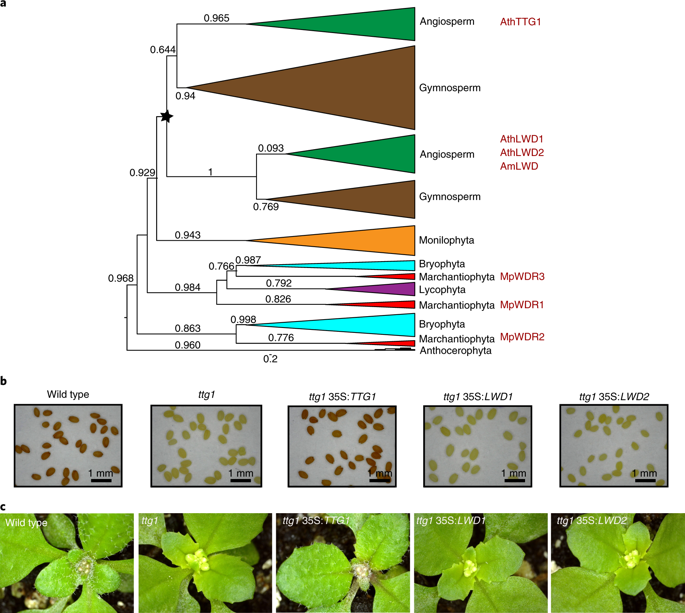当前位置:
X-MOL 学术
›
Nat. Plants
›
论文详情
Our official English website, www.x-mol.net, welcomes your feedback! (Note: you will need to create a separate account there.)
TTG1 proteins regulate circadian activity as well as epidermal cell fate and pigmentation.
Nature Plants ( IF 18.0 ) Pub Date : 2019-11-11 , DOI: 10.1038/s41477-019-0544-3 Chiara A Airoldi 1 , Timothy J Hearn 1 , Samuel F Brockington 1 , Alex A R Webb 1 , Beverley J Glover 1
Nature Plants ( IF 18.0 ) Pub Date : 2019-11-11 , DOI: 10.1038/s41477-019-0544-3 Chiara A Airoldi 1 , Timothy J Hearn 1 , Samuel F Brockington 1 , Alex A R Webb 1 , Beverley J Glover 1
Affiliation

|
The Arabidopsis genome contains three genes encoding proteins of the TRANSPARENT TESTA GLABRA 1 (TTG1) WD-repeat (WDR) subfamily. TTG1 is a known regulator of epidermal cell differentiation and pigment production, while LIGHT-REGULATED WD1 and LIGHT-REGULATED WD2 are known regulators of the circadian clock. Here, we discovered a new central role for TTG1 WDR proteins as regulators of the circadian system, as evidenced by the lack of detectable circadian rhythms in a triple lwd1 lwd2 ttg1 mutant. This shows that there has been subfunctionalization via protein changes within the angiosperms, with some TTG1 WDR proteins developing a stronger role in circadian clock regulation while losing the protein characteristics essential for pigment production and epidermal cell specification, and others weakening their ability to drive circadian clock regulation. Our work shows that even where proteins are very conserved, small changes can drive big functional differences.
中文翻译:

TTG1 蛋白调节昼夜节律活动以及表皮细胞命运和色素沉着。
拟南芥基因组包含三个编码透明 TESTA GLABRA 1 (TTG1) WD-重复 (WDR) 亚科蛋白质的基因。TTG1 是已知的表皮细胞分化和色素生成调节剂,而 LIGHT-REGULATED WD1 和 LIGHT-REGULATED WD2 是已知的生物钟调节剂。在这里,我们发现了 TTG1 WDR 蛋白作为昼夜节律系统调节剂的新核心作用,这可以通过三重 lwd1 lwd2 ttg1 突变体中缺乏可检测的昼夜节律来证明。这表明被子植物内的蛋白质变化已经发生了亚功能化,一些 TTG1 WDR 蛋白在生物钟调节中发挥了更强的作用,同时失去了色素产生和表皮细胞规格所必需的蛋白质特征,和其他人削弱了他们推动生物钟调节的能力。我们的工作表明,即使蛋白质非常保守,微小的变化也会导致巨大的功能差异。
更新日期:2019-11-13
中文翻译:

TTG1 蛋白调节昼夜节律活动以及表皮细胞命运和色素沉着。
拟南芥基因组包含三个编码透明 TESTA GLABRA 1 (TTG1) WD-重复 (WDR) 亚科蛋白质的基因。TTG1 是已知的表皮细胞分化和色素生成调节剂,而 LIGHT-REGULATED WD1 和 LIGHT-REGULATED WD2 是已知的生物钟调节剂。在这里,我们发现了 TTG1 WDR 蛋白作为昼夜节律系统调节剂的新核心作用,这可以通过三重 lwd1 lwd2 ttg1 突变体中缺乏可检测的昼夜节律来证明。这表明被子植物内的蛋白质变化已经发生了亚功能化,一些 TTG1 WDR 蛋白在生物钟调节中发挥了更强的作用,同时失去了色素产生和表皮细胞规格所必需的蛋白质特征,和其他人削弱了他们推动生物钟调节的能力。我们的工作表明,即使蛋白质非常保守,微小的变化也会导致巨大的功能差异。



























 京公网安备 11010802027423号
京公网安备 11010802027423号